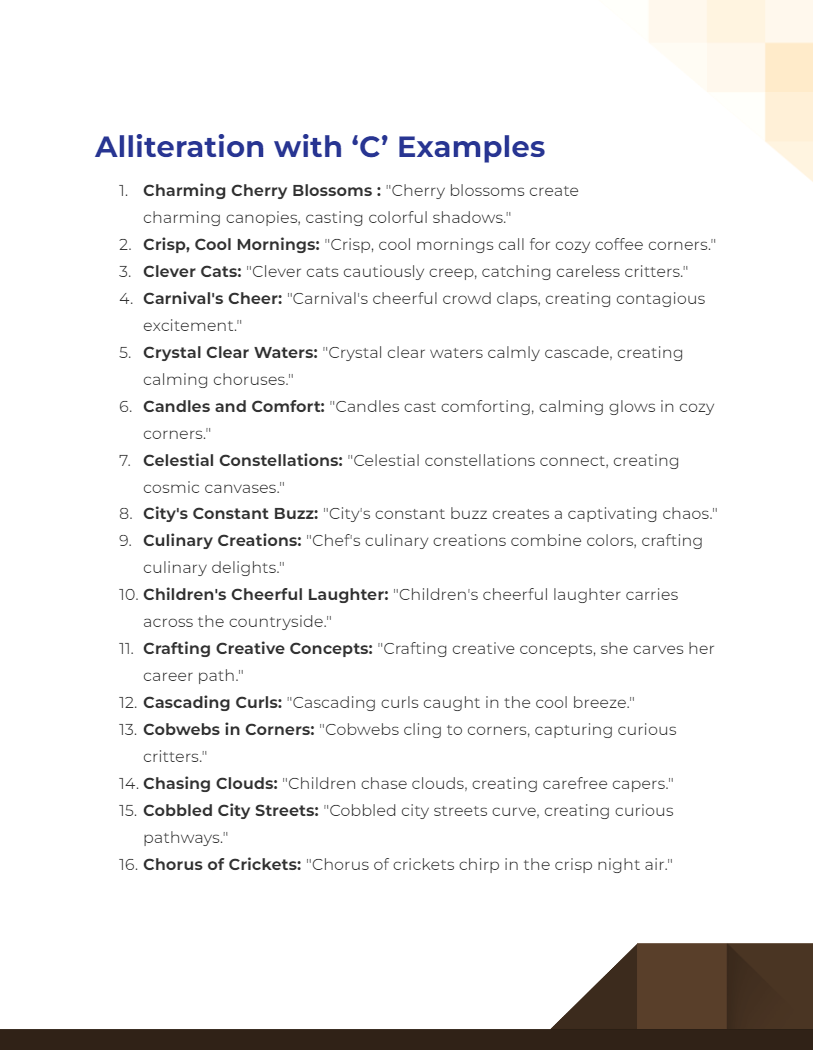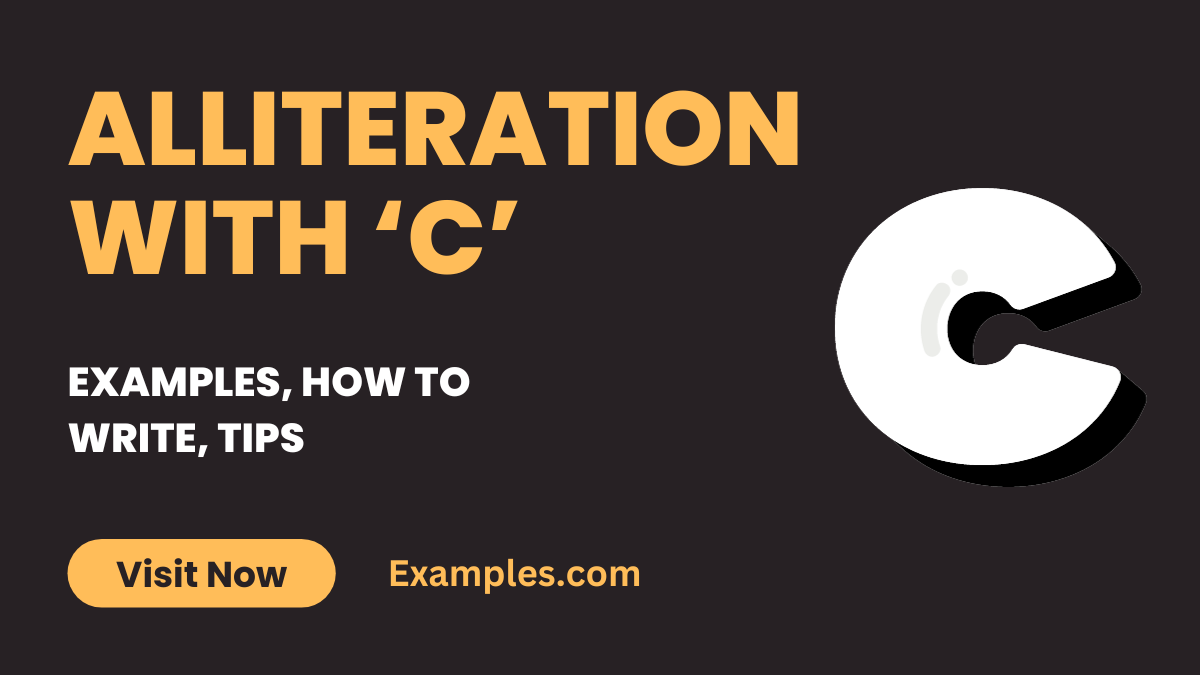16+ Alliteration with C Examples
Alliteration with the letter ‘C’ is a creative and captivating linguistic technique that can add charm and character to writing. It involves the repetition of the ‘C’ sound at the start of adjacent or closely connected words, creating a rhythmic and sometimes musical effect in sentences. This stylistic approach is not only popular in poetry and literature but also widely used in advertising, tongue twisters, and brand names. Mastering alliteration and assonance with ‘C’ can lend a catchy and memorable quality to writing, drawing readers in with its consonantal cadence. Whether you’re crafting poetry, prose, or persuasive content, incorporating ‘C’ alliterations can make your text more engaging and enjoyable for the audience.
Download Alliteration with 'C' Examples
Download Alliteration with 'A' to 'Z' Examples
What is the Best Example of Alliteration with ‘C’?

Example: A classic example of alliteration with the letter ‘C’ is the phrase”Crisp, Crunchy Chips”
Meaning: Alliteration is a literary device where consecutive words in a sentence or phrase begin with the same consonant sound. In the example “Crisp, Crunchy Chips,” the consonant ‘C’ is repeated at the beginning of each word. This repetition not only creates a pleasing sound but also adds emphasis to the words, making them more memorable. Easy Alliteration is commonly used in literature and advertising to make phrases catchy and memorable, enhancing the overall impact of the message.
20 Alliteration with ‘C’ Examples

Download Alliteration with 'C' Examples in PDF
Alliteration in Rhymes using the letter ‘C’ creates a cascade of crisp, clear sounds that can captivate and charm the reader or listener. The versatility of the ‘C’ sound, ranging from soft and subtle to sharp and commanding, allows for a wide array of expressive possibilities. Here, we present 20 unique examples of alliteration with ‘C’, each accompanied by a rhyme title that encapsulates the essence of the alliterative phrase.
- Charming Cherry Blossoms “Cherry blossoms create charming canopies, casting colorful shadows.”
- Crisp, Cool Mornings “Crisp, cool mornings call for cozy coffee corners.”
- Clever Cats “Clever cats cautiously creep, catching careless critters.”
- Carnival’s Cheer “Carnival’s cheerful crowd claps, creating contagious excitement.”
- Crystal Clear Waters “Crystal clear waters calmly cascade, creating calming choruses.”
- Candles and Comfort “Candles cast comforting, calming glows in cozy corners.”
- Celestial Constellations “Celestial constellations connect, creating cosmic canvases.”
- City’s Constant Buzz “City’s constant buzz creates a captivating chaos.”
- Culinary Creations “Chef’s culinary creations combine colors, crafting culinary delights.”
- Children’s Cheerful Laughter “Children’s cheerful laughter carries across the countryside.”
- Crafting Creative Concepts “Crafting creative concepts, she carves her career path.”
- Cascading Curls “Cascading curls caught in the cool breeze.”
- Cobwebs in Corners “Cobwebs cling to corners, capturing curious critters.”
- Chasing Clouds “Children chase clouds, creating carefree capers.”
- Cobbled City Streets “Cobbled city streets curve, creating curious pathways.”
- Chorus of Crickets “Chorus of crickets chirp in the crisp night air.”
- Cinnamon and Spice “Cinnamon and spice create comforting culinary concoctions.”
- Courageous Climbers “Courageous climbers conquer craggy cliffs, craving adventure.”
- Curious Kittens “Curious kittens climb and clamber in cheerful play.”
- Counting Constellations “Counting constellations, children contemplate cosmic mysteries.”
Alliteration Sentence Examples with ‘C’
Creating captivating alliteration sentences with ‘C’ involves using words that begin with the ‘C’ sound to produce a rhythmical and memorable effect. These sentences can vary from whimsical to profound, adding a unique flair to writing. Here are three examples:
- “Calm currents carry colorful coral creatures.”
- “Clouds cloak the crescent moon, casting curious shadows.”
- “Cleverly crafted codes conceal complex secrets.”
Alliteration Examples with ‘C’ Words
Alliteration examples with ‘C’ words play with the crisp, clear sound of the letter ‘C’ to form engaging and rhythmical phrases. These examples demonstrate how ‘C’ words can be used effectively in hard alliteration structures. Here are three examples:
- “Cats claw at curtains, creating chaotic scenes.”
- “Candles flicker, casting curious, dancing shadows.”
- “Cities cloaked in fog create captivating skylines.”
Alliteration Examples with ‘C’ Name
Using names that start with ‘C’ in alliteration adds a personal touch to the literary device, making it more relatable and engaging. Here are three examples:
- “Caroline collected colorful crystals in the countryside.”
- “Carlos courageously conquered challenging climbing courses.”
- “Cassandra’s cat, Cleo, curiously explored the cozy cabin.”
Alliteration Examples with ‘C’ Sound
Alliteration with the ‘C’ sound can produce a range of effects, from soft and subtle to strong and impactful. These alliteration songs examples show the versatility of the ‘C’ sound in alliterative phrases. Here are three examples:
- “Cackling crows circle cornfields at dawn.”
- “Crispy cookies crackle, crumble in cheerful chatter.”
- “Clouds cascade, creating a curtain of rain.”
Alliteration Beginning with ‘C’
Alliteration beginning with ‘C’ often sets the tone of a phrase or sentence with its initial crisp sound. Here are three examples:
- “Cool cucumber slices complement the crunchy salad.”
- “Cathy’s coffee cup clattered on the countertop.”
- “Cascading cherry blossoms create a captivating canopy.”
Alliteration Poem with ‘C’
An alliteration poem with ‘C’ uses the repetitive ‘C’ sound to create a rhythmic and engaging poetic experience. Here are three examples:
- “Cats in corners curled, / Clouds above swirled, / Calm and quiet the world.”
- “Candlelight flickers, casting shapes, / Creatures in the night escape, / Calm descends, a dreamlike drape.”
- “Crisp leaves crackle underfoot, / Crows caw in the crisp air, / Calmness fills the countryside, fair.”
Alliteration Phrases with ‘C’
Alliteration phrases with ‘C’ create a pleasing auditory experience, with the repetition of the ‘C’ sound providing a musical rhythm. Here are three examples:
- “Cunning cats cautiously circle their curious quarry.”
- “Clouds converge, creating a canvas of changing colors.”
- “Crisp, cold air carries the scent of cedar trees.”
How to Write Alliteration with ‘C’?
Writing alliteration answers with the letter ‘C’ involves using words that start with the ‘C’ sound in close proximity to each other. This can add a rhythmic, melodic quality to your writing. Here’s a guide to crafting effective ‘C’ alliterations:
- Identify the ‘C’ Sound: Understand that ‘C’ can have a soft sound (like in “cinder”) or a hard sound (like in “cat”). Decide which sound you want to use for your alliteration.
- Choose a Theme or Subject: Decide on the subject or theme of your writing. This will guide your selection of words and help maintain relevance and context.
- Brainstorm ‘C’ Words: Make a list of words that start with the ‘C’ sound and are relevant to your theme. Use a dictionary or thesaurus for a broader range of words.
- Construct Your Sentence or Phrase: Begin forming sentences or phrases with your chosen words. Arrange them in a way that the ‘C’ sounds are prominent and create a rhythmic flow.
- Read Aloud for Rhythm: Alliteration is as much about sound as it is about repetition. Reading your sentence aloud will help you gauge the rhythm and effectiveness of the alliteration.
- Revise for Impact and Clarity: Edit your sentence to ensure it makes sense and the alliteration enhances rather than detracts from the meaning.
- Incorporate into Your Writing: Integrate your alliterative phrase or sentence into your larger piece, using it to add emphasis, create mood, or enhance the narrative.
Tips for Using Alliteration with ‘C’
- Balance is Key: While alliteration can be engaging, overusing it can overwhelm your audience. Use it sparingly for emphasis or to create a particular effect.
- Maintain Meaning and Clarity: Always ensure that your alliteration does not compromise the clarity of your message. The meaning should remain the primary focus.
- Vary Word Lengths and Sounds: Mix short and long words, as well as soft and hard ‘C’ sounds, to create a more dynamic and interesting alliteration.
- Context Matters: Adapt your use of alliteration to fit the style and tone of your writing. In more formal contexts, subtler alliteration might be more appropriate.
- Use for Emphasis: Alliteration can be a great tool to highlight important concepts or ideas within your text.
- Experiment with Different Forms: Try using alliteration in various forms of writing — from creative to academic — to explore its different effects.
- Consider Pacing: The repetition of sounds in alliteration can affect the pacing of your writing. Use it to speed up or slow down the narrative flow as needed.
What is the Alliteration with ‘C’ for Students?
Alliteration for students with ‘C’ refers to the literary technique of repeating the initial ‘C’ sound in close proximity within a sentence or phrase, typically used to engage and enhance the learning experience. This tool is particularly effective in helping students understand and appreciate the rhythmic and phonetic aspects of language. It can make lessons more memorable and enjoyable, especially in language arts, poetry, and creative writing. For younger students, ‘C’ alliterations can be a fun way to learn vocabulary and phonics, while for older students, they can serve as a method to explore more complex literary concepts and enhance their writing skills.
What is the Effect of ‘C’ Letter in Alliteration?
The effect of the ‘C’ letter in alliteration figurative language is multifaceted. The ‘C’ sound can be soft (as in ‘circle’) or hard (as in ‘cat’), allowing for diverse sonic qualities in a text. The repetition of the ‘C’ sound creates a rhythmic cadence that can make language more engaging and easier to remember. This can be particularly impactful in poetry, advertising, and prose, where the sound of words contributes to the overall effect and message. Alliteration with ‘C’ can add emphasis, create mood, and enhance the thematic elements of a piece. It can make language playful and lyrical, or forceful and commanding, depending on how it is used.
What is the Alliteration ‘C’ Type of?
Alliteration with the letter ‘C’ is a type of consonant alliteration. In this form, the consonant sound at the beginning of adjacent or closely connected words is repeated. Since ‘C’ can produce different sounds (like the soft ‘C’ in ‘cent’ or the hard ‘C’ in ‘cat’), it offers a range of expressive possibilities in great alliteration. This type of alliteration is famous, popular and versatile literary device, used in various forms of writing to create rhythm, enhance mood, and emphasize key points. It’s especially common in poetry, but it’s also used in prose, advertising, and everyday speech for its memorable and sometimes playful effect.


